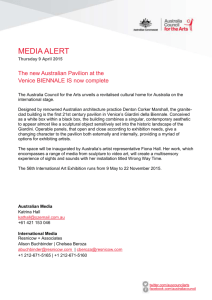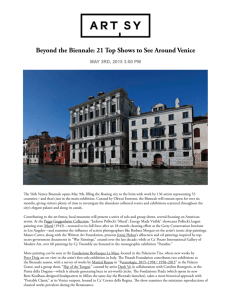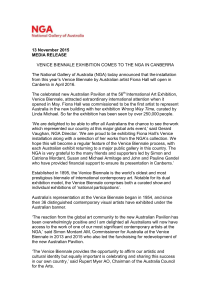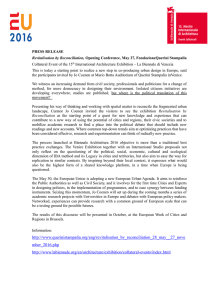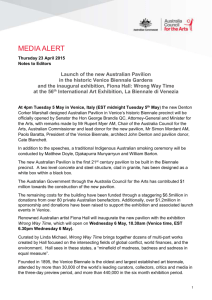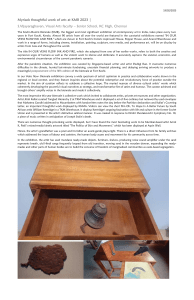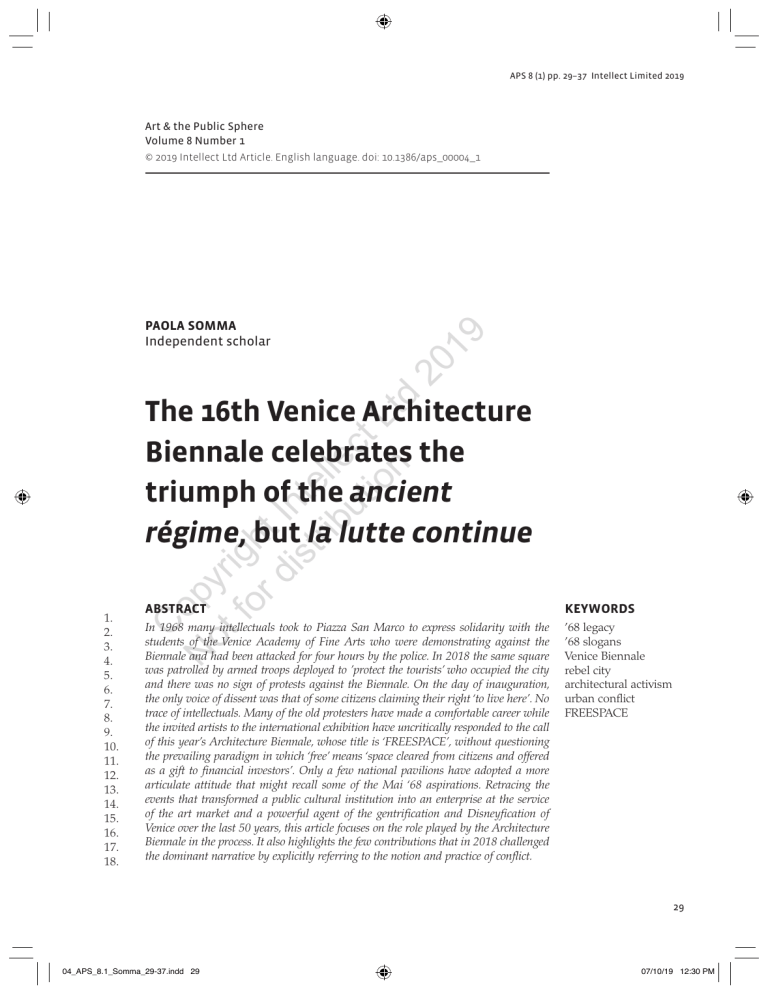
APS 8 (1) pp. 29–37 Intellect Limited 2019 Art & the Public Sphere Volume 8 Number 1 © 2019 Intellect Ltd Article. English language. doi: 10.1386/aps_00004_1 C N opy ot r fo igh rd tI is nte tri ll bu ec tio t L n td 20 19 Paola Somma Independent scholar The 16th Venice Architecture Biennale celebrates the triumph of the ancient régime, but la lutte continue 1. 2. 3. 4. 5. 6. 7. 8. 9. 10. 11. 12. 13. 14. 15. 16. 17. 18. Abstract Keywords In 1968 many intellectuals took to Piazza San Marco to express solidarity with the students of the Venice Academy of Fine Arts who were demonstrating against the Biennale and had been attacked for four hours by the police. In 2018 the same square was patrolled by armed troops deployed to ’protect the tourists’ who occupied the city and there was no sign of protests against the Biennale. On the day of inauguration, the only voice of dissent was that of some citizens claiming their right ‘to live here’. No trace of intellectuals. Many of the old protesters have made a comfortable career while the invited artists to the international exhibition have uncritically responded to the call of this year’s Architecture Biennale, whose title is ‘FREESPACE’, without questioning the prevailing paradigm in which ‘free’ means ‘space cleared from citizens and offered as a gift to financial investors’. Only a few national pavilions have adopted a more articulate attitude that might recall some of the Mai ‘68 aspirations. Retracing the events that transformed a public cultural institution into an enterprise at the service of the art market and a powerful agent of the gentrification and Disneyfication of Venice over the last 50 years, this article focuses on the role played by the Architecture Biennale in the process. It also highlights the few contributions that in 2018 challenged the dominant narrative by explicitly referring to the notion and practice of conflict. ’68 legacy ’68 slogans Venice Biennale rebel city architectural activism urban conflict FREESPACE 29 04_APS_8.1_Somma_29-37.indd 29 07/10/19 12:30 PM Paola Somma Ce n’est qu’un debut C N opy ot r fo igh rd tI is nte tri ll bu ec tio t L n td 20 19 In 1968 during the inaugural days of the Biennale groups of students marched in the Venetian streets carrying posters proclaiming slogans such as ‘Biennale of Capitalists: Well Burn Your Pavilions’ and ‘NO to the Biennale Servant to the Bosses’. When they were assaulted by the police, a number of famous intellectuals, among them the poet Giuseppe Ungaretti and the painter Emilio Vedova, took to Piazza San Marco to express their support. Also, some artists withdrew their works from the exhibition while others wanted to make known their dissent turning the paintings to face the walls and writing on the retro ‘the Biennale is fascist’. Public disorders affected the official opening ceremony, and contributed to the entire edition resulting in an undertone event (Di Stefano 2010). Commenting on the situation a well-known art critic and curator wrote that the Biennale was like a ‘nineteenth century ferry that sails indifferently on the waters of the May revolution’ (Celant 1968: n.pag.). Almost immediately, however, the institution started to restructure itself and adopted a more provocative curatorial agenda for subsequent editions. One of the most significant initiatives was Freedom to Chile, a series of events organized in October 1974 in solidarity with the people of Chile that included movies, public meetings, conferences and exhibitions of posters. Ortensia Allende, the widow of the president murdered by the dictatorship, gave the inaugural speech and a number of exiled Chilean mural artists gathered to form the Brigada S. Allende and toured the city painting murals in the public squares. The event was met with huge success, which gave the impression that the Biennale had really started a new life. But in the following years the board, and the cultural and political élites at large, showed a great ability to distort the meaning of most of the slogans created by the youth who in 1968 protested against the ‘corrupt capitalistic enterprise’, and managed to transform them into promotional and self-celebrating messages. Looking in retrospect, one could say that for the Venice Biennale, 1968 indeed ‘was only a beginning’. Since then it had constantly presented itself as a serious-minded forum different from the art fairs that are the domain of commerce and openly controlled by the art dealers. In fact such statements are contradicted by the succession of decisions and acts that have been instrumental to the transformation of the Biennale in a market showcase and to the increasing involvement of the private interests in the management of the public institution. L’urbanisme est un act politique, il doit être au service du peuple In the 1970s the Biennale expanded the range of the artistic disciplines on stage, which now includes theatre, music, dance and architecture. After some episodic events dedicated to specific architects and buildings, the first Architecture Biennale was inaugurated in 1980. Being dominated by the post modernist architects who with the rise of neoliberalism were becoming increasingly more influential, the exhibition documented the transition to a commodity culture fully integrated into the hegemonic economic and political system and the complete waning of ‘the democratizing impetus that carried calls for reform in 1968’ (Szacka 2016: n.pag.). But what is the function of an exhibition of architecture, by definition the most inherently social discipline? In a very schematic way one could say that 1. 2. 3. 4. 5. 6. 7. 8. 9. 10. 11. 12. 13. 14. 15. 16. 17. 18. 19. 20. 21. 22. 23. 24. 25. 26. 27. 28. 29. 30. 31. 32. 33. 34. 35. 36. 37. 38. 39. 40. 41. 42. 43. 44. 45. 46. 47. 48. 49. 50. 51. 52. 30 Art & the Public Sphere 04_APS_8.1_Somma_29-37.indd 30 07/10/19 12:30 PM The 16th Venice Architecture Biennale celebrates the … 20 19 while an art exhibition sells artworks, an architecture exhibition primarily sells ideology. And indeed, since the 1980s edition, the Architecture Biennale was at the forefront in promoting a radical change of the notion of architecture and urbanism, both as cultural disciplines and as professions. A key element of the new theoretical framework is that architects are not to be praised for their capacity to improve the living conditions in the places that they contribute to transform, but for the ability to put on the scene spectacular images whose extravagance is touted as evidence of visionary genius. Also the meaning of the city underwent a complete turn, becoming synonymous of a resource to be exploited, valorized and put at the disposal of the financial investors. Each of the following editions has adopted and consolidated this paradigm and the Architecture Biennale has been transformed into a powerful machine at the service of the developers, even promoting specific real estate operations that, due to the mere fact of being exhibited in Venice and then ‘donated to the community’, acquire an aura of prestige and a label of quality. Evidences of the way in which the Biennale lends legitimacy to an architect’s project and provides the author a way to get rich assignments in town are numerous. In 2010, to mention just one emblematic case, it exhibited the project of the so-called restoration of the sixteenth-century Fontego dei Tedeschi and its conversion into a luxury mall designed by Rem Koolhaas, who then became director of the Biennale in 2014 (Somma 2014). Moreover, in addition to being a site of convergence for multiple commercial interests, the institution itself keeps expanding its venues and occupying an increasing number of valuable public spaces. This year they took over one of the few surviving public gardens, and cut a number of old trees to provide (free)space to a twelve-metre-tall tower designed by Daniel Libeskind for the joy of tourists. Overall, the Architecture Biennale’s behaviour is exactly the contrary of the 1968 approach that considered architectural interventions the vehicle for political activism in the public sphere and the term political was meant to denote the theoretical and practical knowledge of the social life in the community. Now the Biennale and its court of archistars have consciously taken the side of the power. C N opy ot r fo igh rd tI is nte tri ll bu ec tio t L n td 1. 2. 3. 4. 5. 6. 7. 8. 9. 10. 11. 12. 13. 14. 15. 16. 17. 18. 19. 20. 21. 22. 23. 24. 25. 26. 27. 28. 29. 30. 31. 32. 33. 34. 35. 36. 37. 38. 39. 40. 41. 42. 43. 44. 45. 46. 47. 48. 49. 50. 51. 52. L’imagination au pouvoir Year after year the submissive attitude of the Architecture Biennale to the ‘building compact’ – architectural offices, construction companies, real estate developers, banks and investment groups – has made the true nature of the institution a potent mix of state and corporate support designed to lure international ‘cultural’ tourism increasingly clear. The May ’68 cry ‘tout est politique’ that called for the politicization of the private sphere has eventually resulted in the privatization of the political sphere. In 1998 amendments were introduced to the Biennale’s statute to allow private entities to be members of the board. Paolo Baratta, former minister of the privatizations and former minister of foreign commerce, was appointed president and is still in charge (having managed to obtain a change in the national law that initially provided for a two-term limit). Since then, the growing corporate sponsorship has translated into the transfer of substantial power to the private sector (Madra 2006). In repayment for their generosity, the munificent donors are awarded real decisional www.intellectbooks.com 31 04_APS_8.1_Somma_29-37.indd 31 07/10/19 12:30 PM Paola Somma C N opy ot r fo igh rd tI is nte tri ll bu ec tio t L n td 20 19 power and they influence the selection of the celebrities whose participation is essential to the return in image for the sponsors and even the choice of the directors of the exhibition. The case of Rolex, since 2014 the exclusive partner (not merely a sponsor) of the Biennale, is the culmination of this process. Several archistars who work frequently for Rolex appear constantly among the invited: from Kazuyo Sejima who was the director of the 2010 edition and designed the Rolex Learning Centre in Lausanne, to David Chipperfield, director in 2012, and then eight members of the Rolex mentorship programme. In the booklet prepared for this year’s edition, the company claims ‘its commitment to world-class architecture’, and expresses enthusiasm about the theme chosen by the curators, ‘which focuses on a deep sense of generosity of spirit and sense of humanity of architecture’. But this year the luxury brand went further and erected its own pavilion in the precinct of the Biennale. The building ‘reminiscent of the elegant fluted Bezel of the Oyster perpetual day-date is designed to resemble a watch bracelet’ and to confirm ‘the link between exceptional architecture and watchmaking that is based on a shared culture of design excellence’. The message conveyed by this gesture is more than symbolic. Since 1907 the foreign pavilions have been built at various times by exhibiting nations on public land (owned by the municipality). The first pavilions, Great Britain, France and Germany, were erected close to each other in a place reserved for the great powers and whose arrangement expresses the relations and political powers leading up to the First World War. In the same period also the Russian pavilion was built below the German one. Now the Rolex’s pavilion is the concrete evidence that the company, richer and more powerful than many sovereign countries, behaves as a national state and the Biennale agrees. Their philosophy is summed up in the slogan standing in their advertising poster ‘a Rolex will never change the world, we leave that to the people who wear them’, a perfect demonstration that while the attempts to establish the primacy of the imagination and to use architecture to attack the establishment have failed, the power had taken full control of the creative process. Non aux bidonvilles, non aux villes bidons A redefinition of the physical and ethical character of cities was one of the most compelling aspirations of the ’68 movements. Taking inspiration from the seminal works on urban life by Guy Debord and Henry Lefebvre, artists and activists claimed that changing the city was the precondition for any successful change in the social, political and economic status quo. In other words, changing the city was not a technical issue but a moral imperative. In particular Lefebvre had pointed out that the right to the city is not the right to the existing city, but the right to produce a different one that could be defined only by imagining the reversal of the current situation. Also, he had elaborated on the assumption that the production of space is the way in which the capitalistic mode of production maintains itself and urbanization is crucial to its expansion. Adopting an opposite perspective, the Architecture Biennale uncritically promotes urbanization as the only possible global scenario. That there is no alternative to urbanization has become the predominant approach since the 1. 2. 3. 4. 5. 6. 7. 8. 9. 10. 11. 12. 13. 14. 15. 16. 17. 18. 19. 20. 21. 22. 23. 24. 25. 26. 27. 28. 29. 30. 31. 32. 33. 34. 35. 36. 37. 38. 39. 40. 41. 42. 43. 44. 45. 46. 47. 48. 49. 50. 51. 52. 32 Art & the Public Sphere 04_APS_8.1_Somma_29-37.indd 32 07/10/19 12:30 PM The 16th Venice Architecture Biennale celebrates the … 20 19 2006 edition directed by Ricky Burdett, the founder of the research center Cities and the Urban Age based at the London School of Economics. The centre is financially supported by the Deutsche Bank, which is also one of the most generous sponsors of the Venice Biennale. In 2016 the Biennale provided a venue for the exhibition Conflict in an Urban Age curated by Ricky Burdett and hosted Shaping the Cities in an Urban Age, a conference on the ‘role of architecture in a urban world’. All these events were jointly organized with and sponsored by Deutsche Bank. In fact, the bank, which maintains the larger corporate art collection in the world, is particularly active in supporting art events, but it does not disdain architecture and infrastructure mega projects. They have also created a Deutsche Bank Urban Age Award, whose mission is ‘to make the invisible visible, to show what potential there is in the slums, townships, barrios gekekondus or favelas of this world, and to constitute a lobby for those who have never had one’. Increasingly, indeed, the Architecture Biennale seems satisfied to play an ancillary role and lend cultural legitimacy to the rising power of the financial corporations that dictate the urban agenda and co-opt academics, scholars and local authorities. In addition to this, instead of promoting genuine cultural research and innovation the institution is always ready to catch buzzwords and slogans and turn them into spectacular events that capture masses of visitors. The last editions’ titles, such as People Meet in Architecture (2010) or Common Ground (2012), evoke noble intentions and principles. What is put on stage, however, rarely corresponds to the statements of principle. Most often the content of the exhibition represents a true détournement of the titles that are interpreted in such a way that creates pro- corporate messages and promotes a gradual dissipation of the theoretical embedding of architecture within an agenda of societal reconstruction. As a consequence, the right to the city no longer means the legitimate aspiration of the inhabitants to build a different urban scenario, but the right of the corporate financial interests to decide where people must congregate to make the land more profitable. This general trend is manifest in this year particularly conservative edition whose curators do not even mention the 50th anniversary of the ’68. The title, FreeSpace, might appear reminiscent of the reflections on urban geography by Debord, who called for a ‘survey of the residual and interstitial spaces of the city on a search for elements that might be salvaged from the dominant culture and put to new use in a utopian reconstruction of social space’. In reality the exhibition is the true celebration of the role of architects as accomplices of the power. The choice of the invited artists in itself is significant to this respect. Some parts of the world have almost completely disappeared from the Biennale map. None from Russia or from the Middle East countries are among the invited. The entire African continent is represented by just one South African white male and there is a striking predominant presence of powerful participants from a few countries: twelve from Switzerland, ten from United Kingdom and six from the United States, which means that the architects from three countries represent more than one third of the total number of 71. The rest are the usual suspects, the archistars who use the room as a corporate showcase to display their greatest hit and their flagship constructions. C N opy ot r fo igh rd tI is nte tri ll bu ec tio t L n td 1. 2. 3. 4. 5. 6. 7. 8. 9. 10. 11. 12. 13. 14. 15. 16. 17. 18. 19. 20. 21. 22. 23. 24. 25. 26. 27. 28. 29. 30. 31. 32. 33. 34. 35. 36. 37. 38. 39. 40. 41. 42. 43. 44. 45. 46. 47. 48. 49. 50. 51. 52. www.intellectbooks.com 33 04_APS_8.1_Somma_29-37.indd 33 07/10/19 12:30 PM Paola Somma Les murs ont la parole C N opy ot r fo igh rd tI is nte tri ll bu ec tio t L n td 20 19 Despite the reactionary approach of the main section, the answers provided by the national pavilions are very diverse and some of them offer more articulate insights that challenge the seemingly invincible complicity of architects with the global concentration of power. Echoes of and allusions to the spirit of the ’68 are especially noticeable in the South American countries’ pavilions that openly refer to the freedom of imagination and explore new dialogues between geographies, places and architecture. ‘The world is a set of possibilities and not just a set of realities […] other worlds can be created from the same materials’, say the contributors to the Brazilian pavilion, who explicitly recall the ‘idea of play as a subversive strategy to change the modern spectacle city and turn it into a city full of ludic possibilities’ (Rosa 2018: n.pag.). The exhibition, entitled Walls of Air, looks at Freespace from the point of view of the ongoing urbanization in Brazil and aims at making visible ‘the forms of spatial and conceptual separations that have resulted from the urbanization process’. One part focuses on projects that use architecture as a tool ‘to measure conflict, transition between public and private domains and connection between different urban fabrics’. The other consists of a series of cartographic designs that display complex data on the spatial politics of contemporary Brazil, showing the different sorts of walls that construct a divided city. Particularly intriguing is the section that deals with pixo, the black letter-like sprayed graphics that ‘challenge the power dynamics in the city’. The map not only shows the geographical distribution of the pixo in Sao Paulo; on top of that appear the fines applied to the writers/offenders and the news with their date, media vehicle and headlines that mention pixo. Finally, to show the concentration of power in the repression of those marginalized activity and to contribute to a reflection on ‘how much Brazilian architecture and its urban development are, in fact, free’ the map cross references these data with buildings’ square metre prices and with emblematic cultural institutions that pixadores have sprayed at. The exhibition is complemented by a rich catalogue that, in a format unlike the traditional one, summarizes the exercise of exploration, discussion and debate that have been developed in the process of constructing the exhibition. Ten broad themes – from ‘the map is not the territory’ to ‘the geography of the real estate market’ – are investigated. In the chapter on pixo, entitled ‘the encryption of power: disobedience and exclusion in the city’, the authors highlight ‘how liberating can pixo be in revealing the city’s power logic and the underlying dynamics that define inclusion and exclusion’. They discuss how pixadores use ‘the city as a notebook and each wall is as a sheet’ to expose issues such as the privatization of public space and the government’s negligence towards a class that has few outlets of expression. By ‘decrying rights to the city, which are denied to most people’ the pixadores put into practice the ’68 slogans that proclaimed ‘la beauté est dans la rue’ (‘beauty is in the streets’) and ‘la police s’affiche aux Beaux Arts les Beaux Arts affichent dans la rue’ (‘the police are occupying the Beaux Arts, the Beaux Arts occupy the street’). 1. 2. 3. 4. 5. 6. 7. 8. 9. 10. 11. 12. 13. 14. 15. 16. 17. 18. 19. 20. 21. 22. 23. 24. 25. 26. 27. 28. 29. 30. 31. 32. 33. 34. 35. 36. 37. 38. 39. 40. 41. 42. 43. 44. 45. 46. 47. 48. 49. 50. 51. 52. 34 Art & the Public Sphere 04_APS_8.1_Somma_29-37.indd 34 07/10/19 12:30 PM The 16th Venice Architecture Biennale celebrates the … Non à l’état policier 20 19 Prison to Prison, an intimate story between two architectures, is the title of the exhibition organized by the curators of the pavilion of Uruguay. Their project/research started from a reflection on the fact that the biggest building constructed in Uruguay in 2017 is a prison, the first public–private partnership experience as far as prisons are concerned, which ‘makes us think of our collective fears and desires an also of the scopes and limitations of architecture’. The prison, built by a foreign company, is located in Punta de Rieles, a district of Montevideo, and is a large-scale replica of an imported model. Surrounded by a high concrete wall it is adjacent to an existing prison, known as the village-like prison, where since 2014 a unique experience of collective transformation with the participation of the inmates has been developed. A ‘vibrant neighborhood that imitates the outside inside’, resulting in an ‘unexpected Freespace’, has been built by the prisoners themselves without any input from architects or academics, but with the support of the Director Luis Parody, who was an exile in France during the dictatorship, and is convinced that ‘prisoners can only learn dignity if they are treated with dignity’. By telling the story of the two prisons the curators formulate questions whose significance transcends the specific case. They make it clear how the two colliding spaces establish dialectic relationships, how the two opposite architectures in terms of their understanding of punishment, surveillance, technique, space and power coexist and are inhabited. They extend the confrontation of two specific buildings to ‘two visions of architecture of which these two prisons are a contemporaneous living image, that is a police architecture, consisting in repression and privatization of everything, in juxtaposition to a political architecture’ (Aldama et al. 2018: n.pag.). The catalogue not only reproduces the materials exhibited in the pavilion; it includes critical texts that elaborate on the very question at stake, that is, ‘why and how architecture takes part in the destruction of human beings? and at the same time, why and how architecture can make life possible, potentiate and celebrate life, even in the least expected place?’. Multiple answers are possible, but all share the notion that space is a contested terrain and that today architecture maintains its intrinsically political role as ‘a place of work, conflict, and […] joy’. C N opy ot r fo igh rd tI is nte tri ll bu ec tio t L n td 1. 2. 3. 4. 5. 6. 7. 8. 9. 10. 11. 12. 13. 14. 15. 16. 17. 18. 19. 20. 21. 22. 23. 24. 25. 26. 27. 28. 29. 30. 31. 32. 33. 34. 35. 36. 37. 38. 39. 40. 41. 42. 43. 44. 45. 46. 47. 48. 49. 50. 51. 52. La lutte continue The statement the city is us, a clear reminder of the ’68 cry ‘l’etat c’est moi’, appears in the first lines of the introduction to the catalogue of the Venezuelan pavilion, which the Los Angeles Times has defined ‘the most dissonant pavilion’ of this Biennale. The entire exhibition entitled CCS Espacio Rebelde focuses on the idea of ‘rebel space’ that implies, according to the curator Nelson Rodriguez, ‘a process of inclusive consensus, collective construction, and community agreements’. Three urban axes of Caracas that are ‘the scene of the historical struggle between the capitalist model prevailing on the planet and the Bolivarian socialism of the 21st century’ are taken into consideration. These spaces that have been reoccupied, revalued and re-inhabited and are now open and free for the enjoyment of the wider community are ‘a first step in the process of democratizing the use of urban land’. www.intellectbooks.com 35 04_APS_8.1_Somma_29-37.indd 35 07/10/19 12:30 PM Paola Somma Adopting a language that reminds many of the ’68 instances, the curators show how, in response to the neoliberalism, social movements can reshape the terrain of the politics and the city, and how ‘public social spaces can emerge where popular leadership reconfigures the right to the city’ a right that is violently contested by those who have historically already enjoyed it. Conclusion C N opy ot r fo igh rd tI is nte tri ll bu ec tio t L n td 20 19 As any other cultural institution, the Venice Biennale not only mirrors the political and social attitudes of the times, but is an instrument potentially available to either perpetuate or innovate the dominant cultural discourse. In 1968 the Biennale was obliged to modify its format, but in the following years by stealing the power of the words that protesters used themselves, corporate interests and their political affiliates have managed and taken complete control of the agenda. Now public relations and marketing fuse with high-profile cultural generosity, while aptly publicized slogans pushing somewhat vague concepts are supposed to prove their social concerns. The events of 1968 drove change in the attitudes of architects who were forced to critically reflect on the role of their profession and adopt a selfreflexive thinking on their work. However, what emerges today is a diffuse adaptation to the hegemonic political trends and a serious level of detachment between statements of principle and actual behaviour. In 1968 Whitney M. Young Jr, the activist and director of the National Urban League, addressing the convention of the American Architects Association, said: ‘you are not a profession that has distinguished itself by your social and civic contributions to the cause of civil rights […]. you are most distinguished by your thunderous silence and your complete irrelevance’ (Cramer 2018: n.pag.). This denouncement could have been a good starting point for a reflection of the legacy of the ’68, but the Venice Architecture Biennale seems not even have noticed the anniversary. Despite the institution’s indifference, however, some countries from the ‘periphery of the empire’ still struggle and are proud to exhibit their ’68 aspirations. References Aldama, S., Colom, F., Morera D., Rios, J. and Wood, M. (eds) (2018), Prison to Prison: An Intimate Story between Two Architectures, Montevideo: Quiroga & Rambla. Celant, G. (1968), ‘Una Biennale in grigio verde’, Casabella, 32:8, pp. 52–56. Cramer, N. (2018), ‘Architecture, equity and activism: 1968 to now’, architectmagazine.com, 8 May, https://www.architectmagazine.com/ practice/architecture-equity-and-activism-1968-to-now_o. Accessed 20 August 2018. Di Stefano, C. (2010), ‘The 1968 Biennale: Boycotting the exhibition: An account of three extraordinary days’ in C. Ricci (ed.), Starting from Venice, Milano: Etal, pp. 130–33. Kozlowski, G., Fierro, L., Rosa, M. M. and Camacho, S. (eds) (2018), Walls of Air, Sao Paulo: Bienal de Sao Paulo. Madra, Y. M. (2006), ‘From imperialism to transnational capitalism: The Venice Biennale as a transitional conjuncture’, Rethinking Marxism, 18:4, pp. 525–37. 1. 2. 3. 4. 5. 6. 7. 8. 9. 10. 11. 12. 13. 14. 15. 16. 17. 18. 19. 20. 21. 22. 23. 24. 25. 26. 27. 28. 29. 30. 31. 32. 33. 34. 35. 36. 37. 38. 39. 40. 41. 42. 43. 44. 45. 46. 47. 48. 49. 50. 51. 52. 36 Art & the Public Sphere 04_APS_8.1_Somma_29-37.indd 36 07/10/19 12:30 PM The 16th Venice Architecture Biennale celebrates the … Rodriguez, N. (ed.) (2018), Caracas Rebel Space, Venezuela pavilion, Caracas: Instituto de las Artes de la Imagen en el Espacio. Rosa, M. L. (2018), ‘Contesting urban borders: Cultural practices, design and the construction of urban situations’ in G. Kozlowski, L. Fierro, M. Rosa and S. Camacho (eds), Walls of Air, Sao Paulo: Bienal de Sao Paulo. Somma, P. (2014), Mercanti in fiera, La Biennale di Architettura di Venezia: Progetti in vetrina o città in vendita?, Venezia: Corte del Fontego. Szacka, L. C. (2016), Exhibiting the Postmodern: The 1980 Venice Architecture Biennale, Venezia: Marsilio. Suggested citation 19 Somma, P. (2019), ‘The 16th Venice Architecture Biennale celebrates the triumph of the ancient régime, but la lutte continue’, Art & the Public Sphere, 8:1, pp. 29–37, doi: 10.1386/aps_00004_1 20 Contributor details Paola Somma taught urban planning and design at the IUAV University of Venice, Italy (1980–2000). Since retiring, she operates as an independent scholar. Her main focus of expertise lies on investigations between social and economic structure and urban space. Among her publications on Venice are Venezia: da città a marchio di successo in Il diritto alla città storica (e.book, 2018); Mercanti in fiera: la Biennale di Architettura di Venezia, progetti in vetrina o città in vendita? (2014); Imbonimenti: la Laguna, terra di conquista (2012); Benettown: vent’anni di mecenatismo (2011). C N opy ot r fo igh rd tI is nte tri ll bu ec tio t L n td 1. 2. 3. 4. 5. 6. 7. 8. 9. 10. 11. 12. 13. 14. 15. 16. 17. 18. 19. 20. 21. 22. 23. 24. 25. 26. 27. 28. 29. 30. 31. 32. 33. 34. 35. 36. 37. 38. 39. 40. 41. 42. 43. 44. 45. 46. 47. 48. 49. 50. 51. 52. E-mail: paolamariasomma@gmail.com Paola Somma has asserted her right under the Copyright, Designs and Patents Act, 1988, to be identified as the author of this work in the format that was submitted to Intellect Ltd. www.intellectbooks.com 37 04_APS_8.1_Somma_29-37.indd 37 07/10/19 12:30 PM 04_APS_8.1_Somma_29-37.indd 38 07/10/19 12:30 PM C N opy ot r fo igh rd tI is nte tri ll bu ec tio t L n td 19 20
